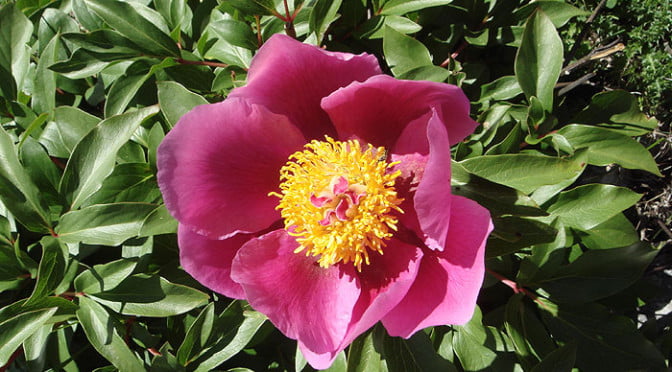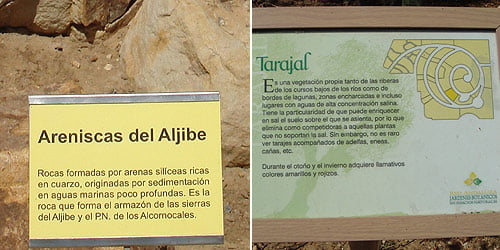Spring is in full swing during the month of May and the plants in flower are so numerous that it is difficult to choose which ones to mention here. You will see that the waysides and meadows hold a tremendous variety, pause to count how many species you can find in just one square metre! Note that there is a subtle difference between the flowering times in the sheltered valleys to that of the exposed higher pastures. Look below the featured plants here, to see a condensed list to whet your appetite! (Grouped by colour). Flowering plants – May in the Sierra de Grazalema
Spanish Iris (Iris xiphium) This is a tall and slender iris which has blue flowers with yellow areas on the falls (cascading petals).The three central petals (standards) are erect. There can be one or two flowers on the same stem which remain open for several days. The leaves which sheath the flowering stem are grey/green, the lowest is long and tapering, the highest shorter and more upright. They can be seen in grassy or rocky areas, beside roads and field edges or in scrubland. Distribution: Iberia eastwards to Italy and NW Africa.






Yellow Retama (Retama (Lygos) sphaerocarpa)
Perfumed, small yellow flowers cover this large (2 to 3metres) broom like shrub. When unchecked it can cover hillsides and pastures. There are very few leaves on the many fine branches, giving this upright plant a dense but wispy and silvery appearance. It prefers a dry habitat and forms good thickets for small bird and insect life. Flowering time is April to June. Distribution: Southern Spain, Portugal and North Africa.
Crambe filiformis
Each individual flower is made up of four tiny white petals, sparsely decorating the tips of the extremely fine, spindly stems – which can grow to around 1 metre. There can be several flowering stems from the basal rosette of leaves. Found in limestone areas at roadsides, on rocky slopes and in open scrub, flowering from April to June. Distribution: Southern Spain and North Africa.
Navel-wort (Omphalodes commutata)
This is a small plant with pure white flowers (reminiscent of forget-me-nots) on finely branched stems. Broad, silvery blue leaves clasp the stem at the base. They can be found in groups in rocky crevices in the limestone mountain, flowering from April until June. Distribution: Southern Spain and North West Africa.
Peony (Paeonia broteroi)
Incredibly showy, bright pink blooms worthy of a garden planting scheme. The rose-like pink flowers open to around 10cm with numerous yellow stamens adorning the centre. The attractive shiny green, cut leaves form a small bush to around 1 metre. Even the seed heads of this plant are of note, during the autumn they split to reveal pink and black seeds. Grows on open, or sparsely covered mountainsides and in light woodland, flowering from April to July depending on altitude. Distribution: Spain and Portugal.
Purple Phlomis (Phlomis purpurea)
This medium sized shrubby plant, often around 1metre in height, is common in our area. The flowers are more likely to be variants of pink, rather than purple which the name suggests. (Occasionally very pale, or white forms are seen). The flowers are in a circle or whorl clasping the stem, opening at different levels. Looking closely you will notice the individual flowers are hairy as are the stems and leaves. The underside of the leaf is covered in a white felt. They flower from April to June on rocky slopes, scrubland, roadsides and field boundaries. Distribution: Central and Southern Spain, Southern Portugal.
YELLOW
- Spanish broom (Spartium junceum)
- Giant Fennel (Ferula communis)
- Wild Tulip (Tulipa sylvestris)
- Corn marigold (Chrysanthemum segetum)
- Yellow Bartsia (Bartsia trixago)
- Rabbits Bread (Andryala integrifolia)
- Squirting cucumber (Ecballium elaterium)
- Giant Mullein (Verbascum giganteum)
- Spiny Starwort (Pallenis spinosa)
- Small-flowered melilot (Melilotus indicus)
- Crown Daisy (Chrysanthemum coronarium)
- Shrubby Buckler Mustard (Biscutella frutescens)
- Hop Trefoil (Trifolium campestre)
- Everlasting Flower (Helicrhysum stoechas)
- Rock Phagnalon (Phagnalon rupestre)
- Perennial Hyoseris (Hyoseris radiata)
- Yellow Lupin (Lupinus luteus)
- Spiny Broom (Calicotome villosa)
- Lampwick-plant (Phlomis lychnitis)
- Cytinus hypocistis
- Linaria platycalyx
- Draba hispanica
- Biscutella auriculata
- Viola demetria
- Centurea clementii
GREEN, BROWN
- Navelwort (Umbilicus rupestris)
- Brown Bluebell (Dipcadi serotinum)
- Biarum carratracense
WHITE
- Crambe filiformis
- Ornithogalum reverchoni
- Ornithogalum orthophylum
- White Flax (Linum suffruticosum)
- St Bernard’s Lilly (Anthericum baeticum)
- Narbonne Star-of-Bethlehem (Ornithogalum narbonense)
- Sage–leaved Cistus (Cistus salvifolius)
- Narrow-leaved Cistus (Cistus monspeliensis)
- Gum Cistus (Cistus ladanifer)
- Cistus populifolius
- Field bindweed (Convolvulus arvensis)
- White horehound (Marrubium vulgare)
- Paronychia (Paronychia capitata)
- Bear’s breeches (Acanthus mollis)
- White clover (Trifolium repens)
- Bladder campion (Silene vulgaris)
- Mountain Catchfly (Silene Andryalifolia)
- White Bartsia (Bartsia trixago)
- Lesser Dodder (Cuscuta epithymum)
- Spanish thyme (Thymus mastichina)
- White horehound (Marrubium vulgare)
- Hairy Woundwort (Stachys ocymastrum)
- Saxifraga globulifera
- Saxifraga haenseleri
- Saxifraga bourgeana
PINK, BLUE, PURPLE
- Peony (Paeonia broteroi)
- Byzantine Gladiolus (Gladiolus communis subsp byzantinus)
- Purple Phlomis (Phlomis purpurea)
- Snapdragon (Antirrhinum majus)
- Anthyllis vulneraria subsp. arundana
- Grey-leaved cistus (Cistus albidus)
- Cistus crispus
- Rosy Garlic (Allium roseum)
- Grey-leaved Cistus (Cistus albidus)
- Evergreen rose (Rosa sempervirens)
- Rosa pouzinii
- Honeysuckle (Lonicera implexa)
- Common mallow (Malva sylvestris)
- Malva hispanica
- Malva cretica subsp. althaeoides
- Opium Poppy (Papaver somniferum)
- Mallow-leaved Bindweed (Convolvulus altheoides)
- Lesser centaury (Centaurium erythraea)
- Cheirolophus sempervirens
- Annual Valerian (Centranthus calcitrapae)
- Centranthus macrosiphon
- Annual Leek (Allium ampeloprasum)
- Sedum mucizonia
- White-leaved bugloss (Echium albicans)
- Candle bugloss (Echium boissieri)
- Reversed Clover (Trifolium resupinatum)
- Purple vetch (Vicia benghalensis)
- Fairy foxglove (Erinus alpines)
- Woolly clover (Trifolium tomentosum)
- Tree mallow (Lavatera arborea)
- Weasel’s snout (Misopates orontium)
- Long-stalked Crane’s-bill (Geranium columbinum)
- Cut-leaved Cranesbill (Geranium dissectum)
- Shining cranesbill (Geranium lucidum)
- Dove’s-foot Crane’s-bill (Geranium molle)
- Round-leaved Crane’s-bill (Geranium rotundifolium)
- Three-lobed Stork’s-bill (Erodium chium)
- Purple Milk Thistle (Galactites tomentosa)
- Small-flowered catchfly (Silene gallica)
- French Figwort (Scrophularia canina)
- Melancholy Toadflax (Linaria tristis)
- Cliff-hanger (Chaenorrhinum villosum)
- Large Blue Alkanet (Anchusa azurea)
- Borage (Borago officinalis)
- Viper’s Bugloss (Echium plantagineum)
- Blue Aphyllanthes (Aphyllanthes monspeliensis)
- Spanish love-in-a-mist (Nigella papillosa subsp. papillosa)
- Giant Squill (Scilla peruviana)
- Shrubby Gromwell (Lithodora fruiticosum)
- Spanish Lavender (Lavandula stoechas)
- Dwarf Morning Glory (Convolvulus tricolour)
- Blue Lupin (Lupinus micranthus)
- Pitch trefoil (Bituminaria bituminosa)
- Blue lettuce (Lactuca tenerrima)
- Scarlet Pimpernel (blue form) (Anagallis arvensis)
- Barrelier’s Sage (Salvia barrelieri)
- Mediterranean Catmint (Nepeta tuberosa)
- Rampion (Campanula rapunculus)
- Rampion bellflower (Campanula lusitanica)
- Delphinium pentagynum
- Shrubby germander (Teucrium fruticans)
- Stavesacre (Delphinium staphisagria)
- Large Blue Alkanet (Anchusa azurea)
- Pitch trefoil (Bituminaria bituminosa)
- Blue hounds-tongue (Cynoglossum creticum)
- Southern Campanula (Campanula velutina)
- Small Bellflower (Campanula erinus)
- Campanula specularioides
- Ronda Geranium (Geranium malviflorum)
- Spanish Iris (Iris xiphium)
RED, ORANGE
- Field Poppy (Papaver rhoeas)
- Long-headed Poppy (Papaver dubium)
- Prickly Poppy (Papaver argemone)
- Rough headed poppy (Papaver hybridum)
- Scarlet pimpernel (Anagallis arvensis)
- Asparagus pea (Tetragonolobus purpureus)
- Italian Sainfoin (Hedysarum coronarium)
- Pheasant’s Eye (Adonis annua)
- Pomegranate Tree (Punica granatum)
ORCHIDS
Bee Orchid (Ophrys apifera)
Sawfly Orchid (Ophrys tenthredinifera)
Woodcock Orchid (Ophrys scolopax)
Bee Orchid (Ophrys apifera)
Ophrys dyris
Yellow Bee Orchid (Ophrys lutea)
Pyramidal orchid (Anacamptis pyramidalis)
Champagne Orchid (Orchis) (Anacamptis champagneuxii)
Fragrant Bug Orchid (Orchis coriophora subsp fragrans)
Lax orchid (Orchis laxiflora)
Lange’s Orchid (Orchis langei)
Man orchid (Aceras) (Orchis anthropophorum)
Tongue Orchid (Serapias lingua)
Small-flowered Serapias (Serapias parviflora)
Red Helleborine (Cephalanthera rubra)
Lizard Orchid (Himantoglossum hircinum)
Broad-leaved Helleborine (Epipactis tremolsii)
Dense-flowered Orchid (Neotinea maculata)
Ronda Today
Everything you need to know before you visit Ronda “The city of dreams” in Andalucia. https://www.rondatoday.com/
Wildside Holidays – Spain
Take a trip on the Wildside! Discover the wildlife and nature of Spain, its Natural and National Parks and find the top wildlife, activity and walking holiday companies.














